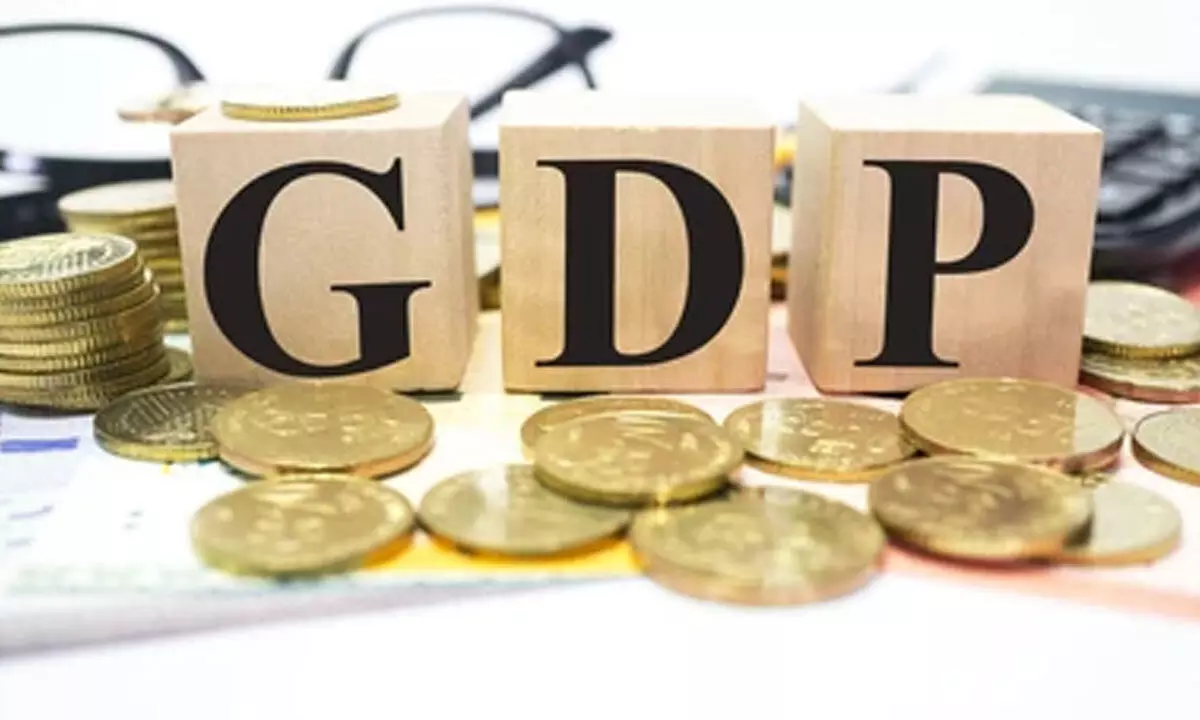Live
- Nizamabad MP Dharmapuri Arvind and Jagtial MLA Dr. Sanjay Kumar Meet CM Revanth Reddy
- Hyderabad CP CV Anand Issues Stern Warning to Bouncers
- MP Laxman Criticizes Police Conduct, Calls for Support for Victims' Families
- Fire Breaks Out in Kachiguda-Chennai Egmore Express, Passengers Evacuated Safely
- CM Revanth Reddy Condemns Attacks on Film Personalities' Homes, Calls for Strict Action
- Victory Venkatesh and Nandamuri Balakrishna to Set Screens on Fire with Unstoppable Season 4
- Over 71.81 crore Ayushman Bharat Health Account numbers generated: Centre
- In special gesture, Kuwait's Prime Minister sees-off PM Modi at airport after conclusion of historic visit
- Veer crowned PGTI Ranking champion, Shaurya wins emerging player honour
- Sr National Badminton: Unseeded Rounak Chauhan, Adarshini Shri reach singles semis
Just In
Rating agencies cut down forecast on GDP growth


Gross domestic product
Crisil lowers FY23 growth by 30 bps to 7%; Icra slashes Q2 GDP to half of last fiscal at 6.5%; Ripple effect of the global slowdown will be felt more next fiscal
Mumbai: Rating agencies Crisil and Icra on Monday revised down their India growth projections for the current fiscal and the second quarter mainly due to the ripple effect of slowdown in global growth and mixed crop output. Crisil downgraded the India growth forecast by 30 bps to seven per cent, while Icra pegged the economic expansion at 6.5 per cent for the second quarter of FY2022-23.
"We have revised down our forecast for real gross domestic product growth to seven per cent for fiscal 2023 from 7.3 per cent, primarily because of the slowdown in global growth that has started to impact our exports and industrial activity. This will test the resilience of domestic demand,"Crisil chief economist Dharmakirti Joshi said in a note.
Aditi Nayar, his counterpart at Icra, in her report pencilled a 6.5 per cent growth in Q2 of the current fiscal, nearly half of the year-ago quarter when the economy had clipped at 12.7 per cent, but which is still a tad higher than the monetary policy committee's September forecast of 6.3 per cent and at 6.5 per cent in gross value added (GVA) less than half of 13.5 per cent a year ago. She attributed the lower numbers to the mixed crop output trends revealed by the advance estimates of Kharif production, adverse input cost movements for certain sectors with a higher fuel intensity, as well as the impact of the flagging external demand on non-oil merchandise exports, which whittled down the gains from robust demand for contact-intensive services, healthy capital spending by government and pre-festive season stocking of goods.
She also said, however, GDP growth over the pre-Covid levels is expected to double to around eight per cent in Q2 relative to 3.8 per cent seen in the previous quarter. The agency estimates the sectoral growth in Q2 to be driven by the services sector (9.4 per cent), with a subdued trend foreseen for the industry (2 per cent), and agriculture, forestry and fishing (2.5 per cent). Joshi said he is paring growth forecast only by 30 bps as domestic demand still remains supportive, helped by a catch-up in contact-based services, government capex, relatively accommodative financial conditions, and overall normal monsoons for the fourth time in a row.
But Joshi warned that the ripple effect of the global slowdown will be felt more next fiscal, which will put domestic demand under pressure as interest rate hikes get transmitted more to consumers, and the catch-up in contact-based services fades.
"Consequently, we expect GDP growth to slow to 6 per cent in fiscal 2024, down from 6.5 per cent estimated previously, with more downside risks to the revised forecast," Joshi said. Despite the markdown in near-term growth, the country is expected to remain a growth outperformer over the medium-run, he said, and expects GDP growth to average 6.6 per cent between fiscals 2024 and 2026, compared to the 3.1 per cent global growth forecast by the International Monetary Fund.
He also sees the country outgrowing her emerging market peers such as China (4.5 per cent growth estimated for 2023-25), Indonesia (5.2 per cent), Turkey (3 per cent) and Brazil (1.6 per cent). Joshi sees stronger domestic demand (private consumption constitutes as much as 57 per cent of GDP) driving growth premium over peers in the medium-term on the back of optimistic investment prospects given the government's capex push, the progress of production-linked incentive scheme, healthier corporate balance sheets, and a well-capitalised banks with low NPAs. The country is also likely to benefit from China-plus-one policy as global supply chains get reconfigured with shifting focus from efficiency towards resilience and friend shoring.

© 2024 Hyderabad Media House Limited/The Hans India. All rights reserved. Powered by hocalwire.com






